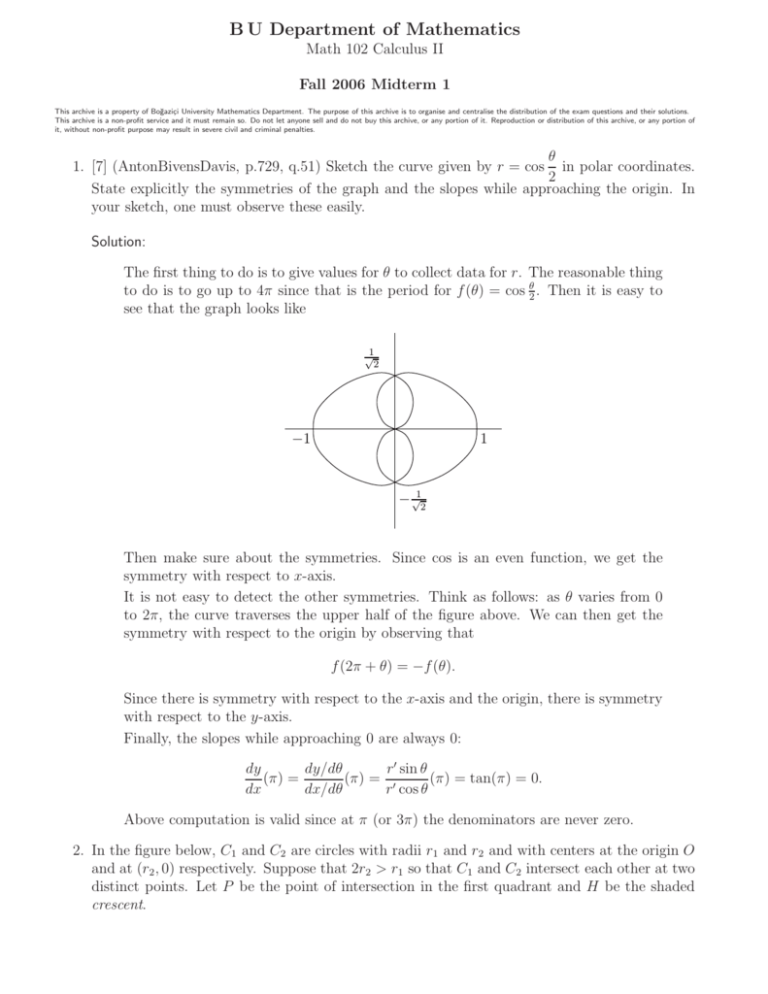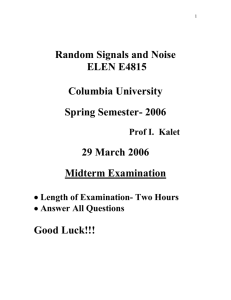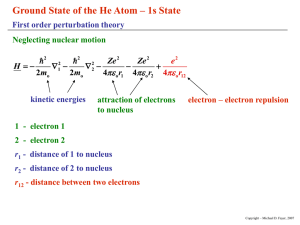B U Department of Mathematics
advertisement

B U Department of Mathematics Math 102 Calculus II Fall 2006 Midterm 1 This archive is a property of Boğaziçi University Mathematics Department. The purpose of this archive is to organise and centralise the distribution of the exam questions and their solutions. This archive is a non-profit service and it must remain so. Do not let anyone sell and do not buy this archive, or any portion of it. Reproduction or distribution of this archive, or any portion of it, without non-profit purpose may result in severe civil and criminal penalties. θ 1. [7] (AntonBivensDavis, p.729, q.51) Sketch the curve given by r = cos in polar coordinates. 2 State explicitly the symmetries of the graph and the slopes while approaching the origin. In your sketch, one must observe these easily. Solution: The first thing to do is to give values for θ to collect data for r. The reasonable thing to do is to go up to 4π since that is the period for f (θ) = cos θ2 . Then it is easy to see that the graph looks like √1 2 −1 1 − √12 Then make sure about the symmetries. Since cos is an even function, we get the symmetry with respect to x-axis. It is not easy to detect the other symmetries. Think as follows: as θ varies from 0 to 2π, the curve traverses the upper half of the figure above. We can then get the symmetry with respect to the origin by observing that f (2π + θ) = −f (θ). Since there is symmetry with respect to the x-axis and the origin, there is symmetry with respect to the y-axis. Finally, the slopes while approaching 0 are always 0: dy dy/dθ r ′ sin θ (π) = (π) = ′ (π) = tan(π) = 0. dx dx/dθ r cos θ Above computation is valid since at π (or 3π) the denominators are never zero. 2. In the figure below, C1 and C2 are circles with radii r1 and r2 and with centers at the origin O and at (r2 , 0) respectively. Suppose that 2r2 > r1 so that C1 and C2 intersect each other at two distinct points. Let P be the point of intersection in the first quadrant and H be the shaded crescent. (a) [1+1] Write down the two equations in polar coordinates that describe C1 and C2 . (b) [2] Find the angle P OB in terms of rr12 . Easiest way is to use the answer to part (a). (c) [4] Write down an integral in polar coordinates for the area of H. Then compute the area in terms of rr12 . P r1 B O r2 C2 C1 Solution: (a) C1 : r = r1 , C2 : (x − r2 )2 + y 2 = r22 ⇒ r 2 = 2r2 x ⇒ r = 2r2 cos θ (b) P is a point of intersection of C1 and C2 . Hence, θ0 = \ P OB = cos−1 ( 1 r1 ) > 0. 2 r2 (c) area(H) = = = = = = = θ0 1 (2r2 cos θ)2 − (r1 )2 ) dθ 2 Z−θθ00 1 + cos 2θ − r12 )dθ (4r22 2 0 sin 2θ (2r22 (θ + ) − r12 θ)θ00 2 2r22 θ0 + r22 sin 2θ0 − r12 θ0 (2r22 − r12 )θ0 + 2r22 cos p θ0 sin θ0 r1 4r22 − r12 (2r22 − r12 )θ0 + 2r22 r2 q2r2 2 2 2 (2r2 − r1 )θ0 + r1 4r2 − r12 . Z 3. [6] (AntonBivensDavis, p.823, q.44) Let a, b, c and d be four vectors that are parallel to a fixed plane. Show that (a × b) × (c × d) = 0. Be as simple as possible but be precise! Solution: Let n be a normal to the plane. Given that a, b, c, d ⊥ n, we have a × b = kn and c × d = ln for some k, l ∈ R. So (a × b) × (c × d) = (kn) × (ln) = (kl)n × n = 0 4. Let D1 and D2 be two distinct, non-parallel planes in R3 and let α be the angle between them. Consider two vectors v1 and v2 parallel to D1 and D2 respectively. Let θ be the angle between v1 and v2 . Assume 0 ≤ α, θ ≤ π. Determine whether the following statements are true or false. For each, if answer is yes, prove the claim. If no, give an example where the claim is not true. (a) [2] It is always true that θ ≥ α. (b) [2] It is always true that θ ≤ α. Solution: Answer is no for both cases. Let L be the line of intersection and v be a vector parallel to L. Then v is parallel to both D1 and D2 . (a) Set v1 = v2 = v. Then θ = 0 < α. (b) Set v1 = v, v2 = −v. Then θ = π > α. 5. [10] Using vector calculus, find the point on the line x + y − z = 2, 3x + y = 1 closest to the point (1, 1, 1). You are not allowed to answer this question by finding the global minimum of an appropriate function! Solution: The case in question is exactly the same as the previous question: two planes intersecting along a line (a line in R3 is given by two independent linear equations). There are several ways to solve this question. Here, we first find the plane D passing through the point P = (1, 1, 1) and normal to the line. A direction n along the line is: n = h1, 1, −1i × h3, 1, 0i = h1, −3, −2i The equation for the plane D is D : h1, −3, −2i · hx − 1, y − 1, z − 1i = x − 3y − 2z + 4 = 0 The closest point Q = (x, y, z) on L to P is the point of intersection of L and D; hence Q satisfies: x + y − z = 2, 3x + y = 1, −x + 3y + 2z = 4 One can then compute that Q = (x, y, z) = (− 8 3 23 , , − ). 14 14 14







